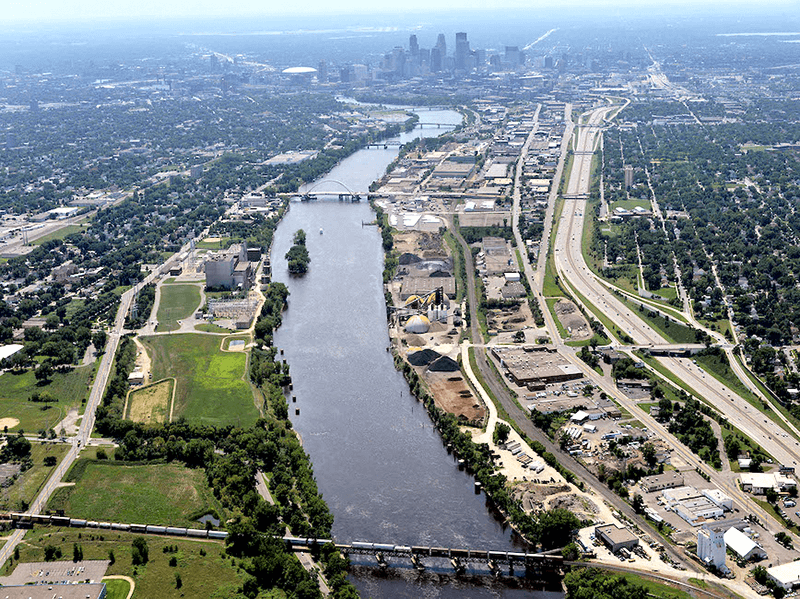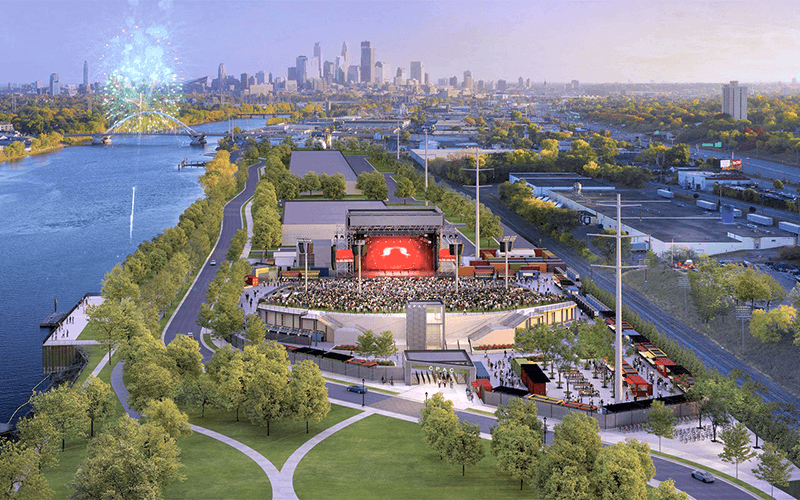
The Upper Harbor site sits along the Mississippi River. (Provided)
In North Minneapolis, a former shipping terminal may be seeing a new life.
At a Minneapolis Business, Housing and Zoning Committee meeting on July 15, representatives and residents from across the city gathered to discuss the future of a potential development at the Upper Harbor.
The proposed project will cover “about a mile of riverfront,” according to the Minneapolis Park and Recreation Board, and it will include bike and pedestrian trails, feature a new parkway road and host native plants on its shoreline. It will also include a community performing-arts center, a small business space and a “health and wellness hub.” The site is currently the largest redevelopment site in the city.
Hilary Holmes, a senior project coordinator with Community Planning & Economic Development (CPED) department, working with the Minneapolis Park and Recreation Board (MPRB) on this project, presented her team’s vision for the site to councilmembers, requesting a long-term lease for operating the performing arts center and asking for $3 million to complete the Upper Harbor site.
“The site is, and will remain, entirely publicly owned,” Holmes said. “The upper harbor is reconnecting and opening up the riverfront to the North side (of Minneapolis). It’s an extension of the McKinley neighborhood while serving as a regional destination and providing regional-level amenities.” The first phase of development, she said, will include a riverfront park, affordable housing, and “an outdoor music performance venue”: the “Community Performing Arts Center (CPAC).” The venue will be able to host 8,000-8,500 people.
In 2023, First Avenue and the Minnesota Orchestra announced their partnership as Port of Minneapolis, LLC (POM), to “jointly operate and develop the CPAC.” After constructing the CPAC, POM aims to provide the surrounding community with employment opportunities for construction, operation and vending. POM, as opposed to the City or the MPRB, will be responsible for the performing arts center.
Dana Frank, CEO of First Avenue Productions, said the project is “shovel-ready” and underlined their efforts to work with the North Minneapolis community.
The site has been developed with North Minneapolis residents in mind. $3 from each ticket sold will go towards a fund overseen by the African American Community Development Corporation (AACDC), with annual proceeds projected to exceed $500,000 annually. “That revenue has the opportunity to fund Northside and BIPOC (Black, indigenous and people of color) vendor opportunities at ticketed and non-ticketed events, skills-based certificate programs and apprenticeship programs, public art, cultural programming and free and low-cost community events.” The site will also feature a “multi-purpose room” to serve as “flexible community space.”
“This project is more than just a venue,” she said. “It’s a long-term investment in local economic vitality, workforce development and inclusive access to the arts. It’s a new model of what cultural infrastructure can look like when it’s built through authentic community engagement, public purpose with committed local partners.”
Ivan Winship, Chief Financial Officer for the Minnesota Orchestra, stated that “in total, over half of all profits from the facility will go towards Minnesota non-profit organizations and the AACDC.”
In Phase 2 of development, CPED plans to build additional parkway, connecting more of the neighborhood to the development and opening up land for private development.
MPRB formerly anticipated a late 2025 opening; that deadline has now been moved to Spring 2026.
Community members respond to development
Keith Baker, a self-described “Twin Cities person for the past 40 years” and executive director at Reconnect Rondo, a nonprofit focused on economic development, said this project had the most potential economic impact of any he’d seen in that time. “I feel like the comprehensive plan points in the right direction,” he said. “This is the type of project the AACDC really supports.”
Bill English, a North Minneapolis resident, expressed concern about gentrification and funding allocation in North Minneapolis at and surrounding the Upper Harbor site. “I am definitely supporting moving forward aggressively on getting this amphitheater up, because it makes a destination point for the upper harbor in an area that this city chartered as a slum,” he said, using some language not fit for print. “This area of the city belongs to the residents of North Minneapolis first. This is to minimize gentrification.”
He continued: “But ask yourself why, in three years, the Minnesota Housing and Finance Agency has not allocated a single nickel for housing where we have the largest amount of homelessness, the most encampments — We contribute more financially to the city than any other. … We have thousands of people waiting for homes and we haven’t had an allocation in three years.”
“I implore you: before I leave this planet,” he said, “approve this plan and advocate for the housing we so desperately deserve. Thank you for your time, and God bless you all.”
Another North Minneapolis resident — “a trail builder by profession” — expressed concern about pedestrians’ ability to walk to the project easily and safely, asking after pedestrian access points. She also said it was “odd that we are putting such an incredible initiative next to a shingle factory. If you walk there and back, you might be sick, because it is so toxic, and we are bringing hundreds of thousands of people out there.”
“The whole world is watching Minneapolis,” she said. “Let’s do the right thing. Let’s talk about clean water, clean air (and) clean food in North Minneapolis.”

A rendering of the Upper Harbor’s proposed amphitheater. (Andy Holmaas)